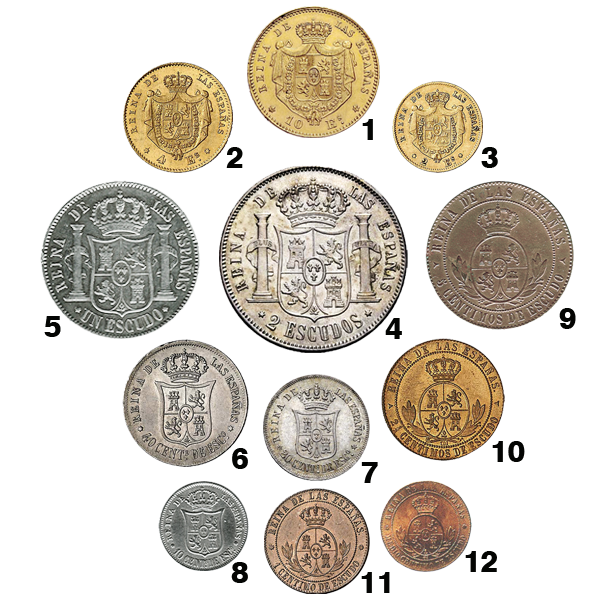Silver Escudo on:
[Wikipedia]
[Google]
[Amazon]
 The escudo was either of two distinct
The escudo was either of two distinct
 The first escudo was a
The first escudo was a
The Colonial Coinage of Spanish America:
' An introduction by Daniel Frank Sedwick'' {{Portal bar, Money, Numismatics, Spain Silver escudo Coins of Spain
 The escudo was either of two distinct
The escudo was either of two distinct Spanish
Spanish might refer to:
* Items from or related to Spain:
**Spaniards are a nation and ethnic group indigenous to Spain
**Spanish language, spoken in Spain and many countries in the Americas
**Spanish cuisine
**Spanish history
**Spanish culture
...
currency
A currency is a standardization of money in any form, in use or circulation as a medium of exchange, for example banknotes and coins. A more general definition is that a currency is a ''system of money'' in common use within a specific envi ...
denominations.
Gold escudo
 The first escudo was a
The first escudo was a gold coin
A gold coin is a coin that is made mostly or entirely of gold. Most gold coins minted since 1800 are 90–92% gold (22fineness#Karat, karat), while most of today's gold bullion coins are pure gold, such as the Britannia (coin), Britannia, Canad ...
introduced in 1535/1537, with coins denominated in escudos issued until 1833. It was initially worth 16 '' reales''. When different reales were introduced, the escudo became worth 16 ''reales de plata'' in 1642, then 16 ''reales de plata fuerte'' or 40 ''reales de vellón'' from 1737.
Coins
Gold coins were issued in denominations of , 1, 2, 4 and 8 escudos, with the 2 escudos coin known as thedoubloon
The doubloon (from Spanish language, Spanish ''doblón'', or "double", i.e. ''double escudo'') was a two-''Spanish escudo, escudo'' gold coin worth approximately four Spanish dollars or 32 ''Spanish real, reales'', and weighing 6.766 grams (0.218 ...
. Between 1809 and 1849, coins denominated as 80, 160 and 320 reales (de vellon) were issued, equivalent, in gold content and value, to the 2, 4 and 8 escudo coins.
Most were minted in Madrid, marked with a superscripted M or in Seville bearing an S below and left of the Royal Coat of Arms. The mintmaster's initials appeared on the opposite side.
Silver escudo
The second escudo was the currency ofSpain
Spain, or the Kingdom of Spain, is a country in Southern Europe, Southern and Western Europe with territories in North Africa. Featuring the Punta de Tarifa, southernmost point of continental Europe, it is the largest country in Southern Eur ...
between 1864 and 1869. It was subdivided into 100 ''céntimos de escudo''. The escudo replaced the ''real
Real may refer to:
Currencies
* Argentine real
* Brazilian real (R$)
* Central American Republic real
* Mexican real
* Portuguese real
* Spanish real
* Spanish colonial real
Nature and science
* Reality, the state of things as they exist, rathe ...
'' at a rate of 10 reales = 1 escudo. It was itself replaced by the '' peseta'', at a rate of pesetas = 1 escudo, when Spain joined the Latin Monetary Union
The Monetary Convention of 23 December 1865 was a unified system of coinage that provided a degree of monetary integration among several European countries, initially Belgium, France, Italy and Switzerland, at a time when the circulation of bank ...
. The later silver escudo was worth one quarter of the earlier, gold escudo.
Coins
Copper coins were issued in denominations of , 1, and 5 céntimos; silver coins of 10, 20 and 40 céntimos, 1 and 2 escudos; and gold coins of 2, 4 and 10 escudos. The 1 escudo was introduced in 1864, followed by the other silver and gold coins in 1865 and the copper coins in 1866. All the coins were minted until 1868, with 10 escudos also minted in 1873 during the First Republic.See also
*Portuguese escudo
The Portuguese escudo (, ) was the currency of Portugal replacing the ''real'' on 22 May 1911 and was in use until the introduction of the euro on 1 January 2002. The escudo was subdivided into 100 . The word literally means shield; like other ...
References
*External links
The Colonial Coinage of Spanish America:
' An introduction by Daniel Frank Sedwick'' {{Portal bar, Money, Numismatics, Spain Silver escudo Coins of Spain